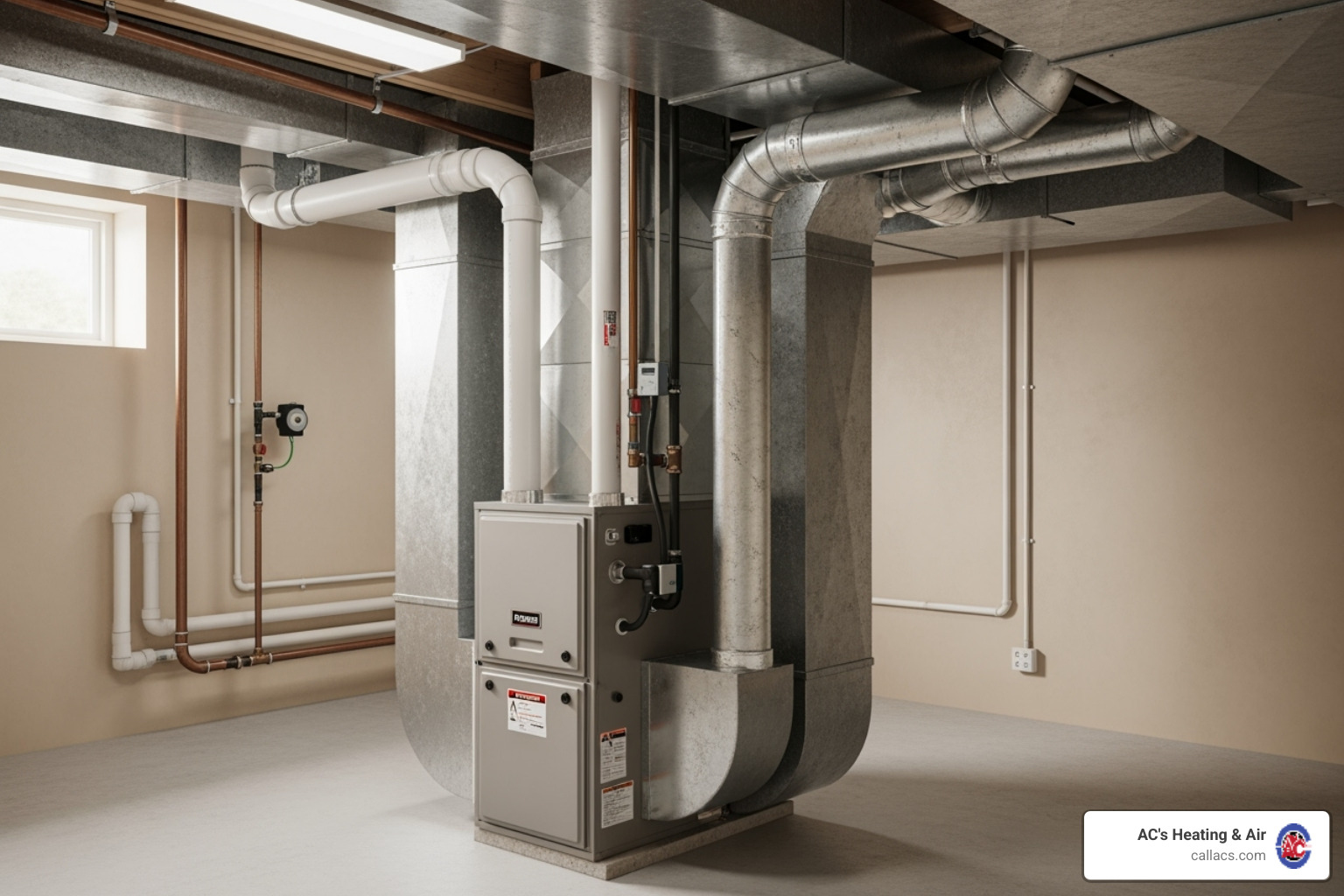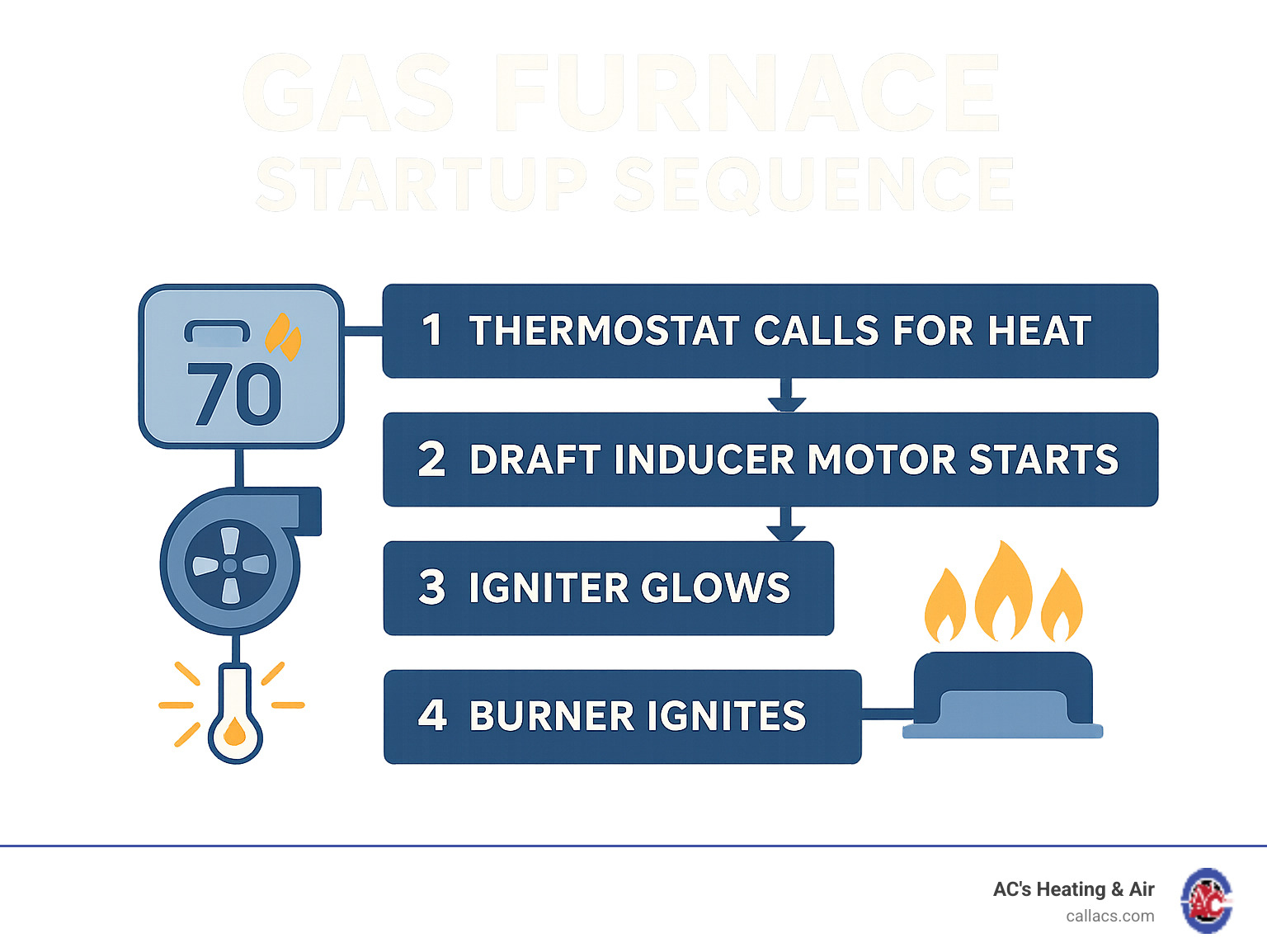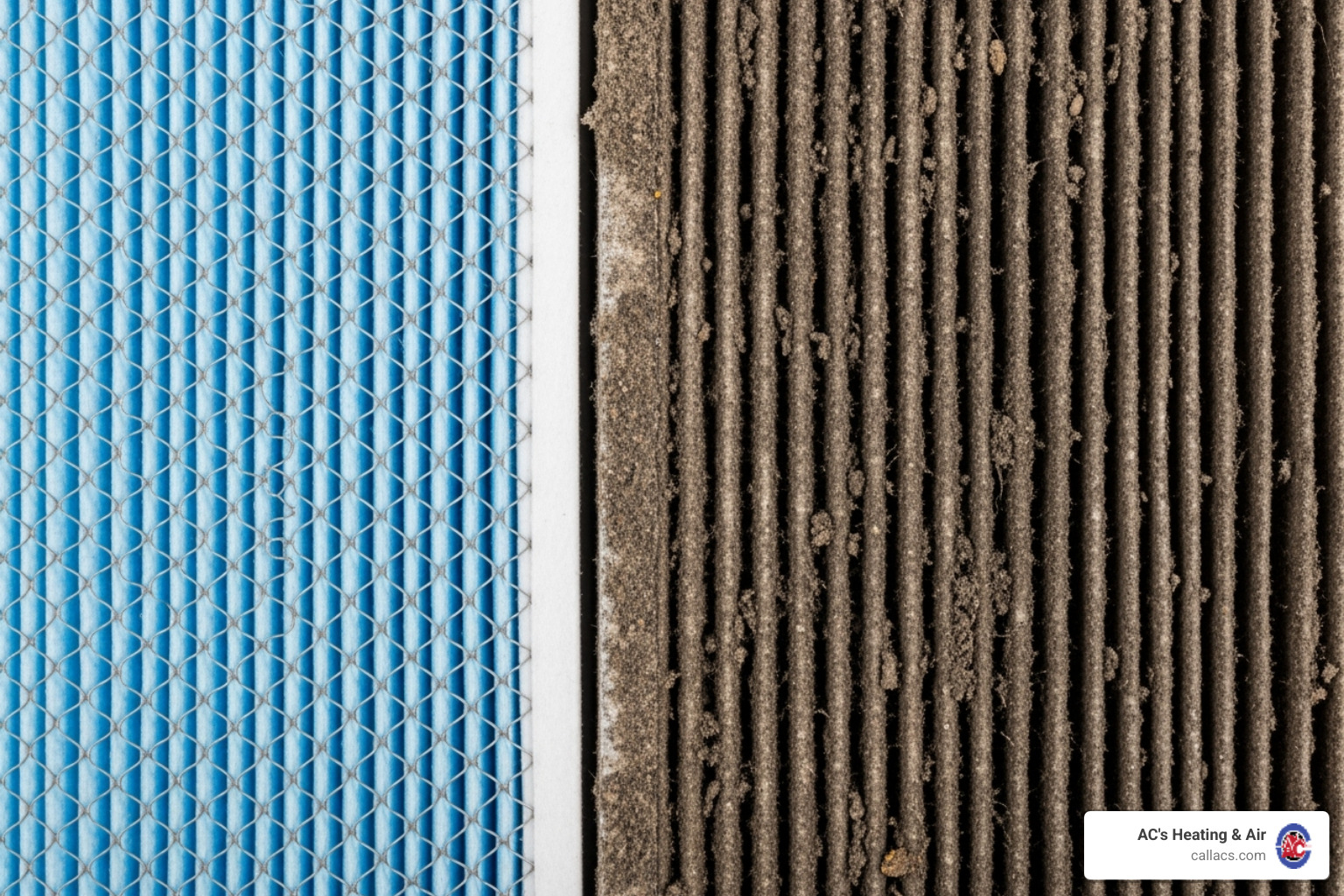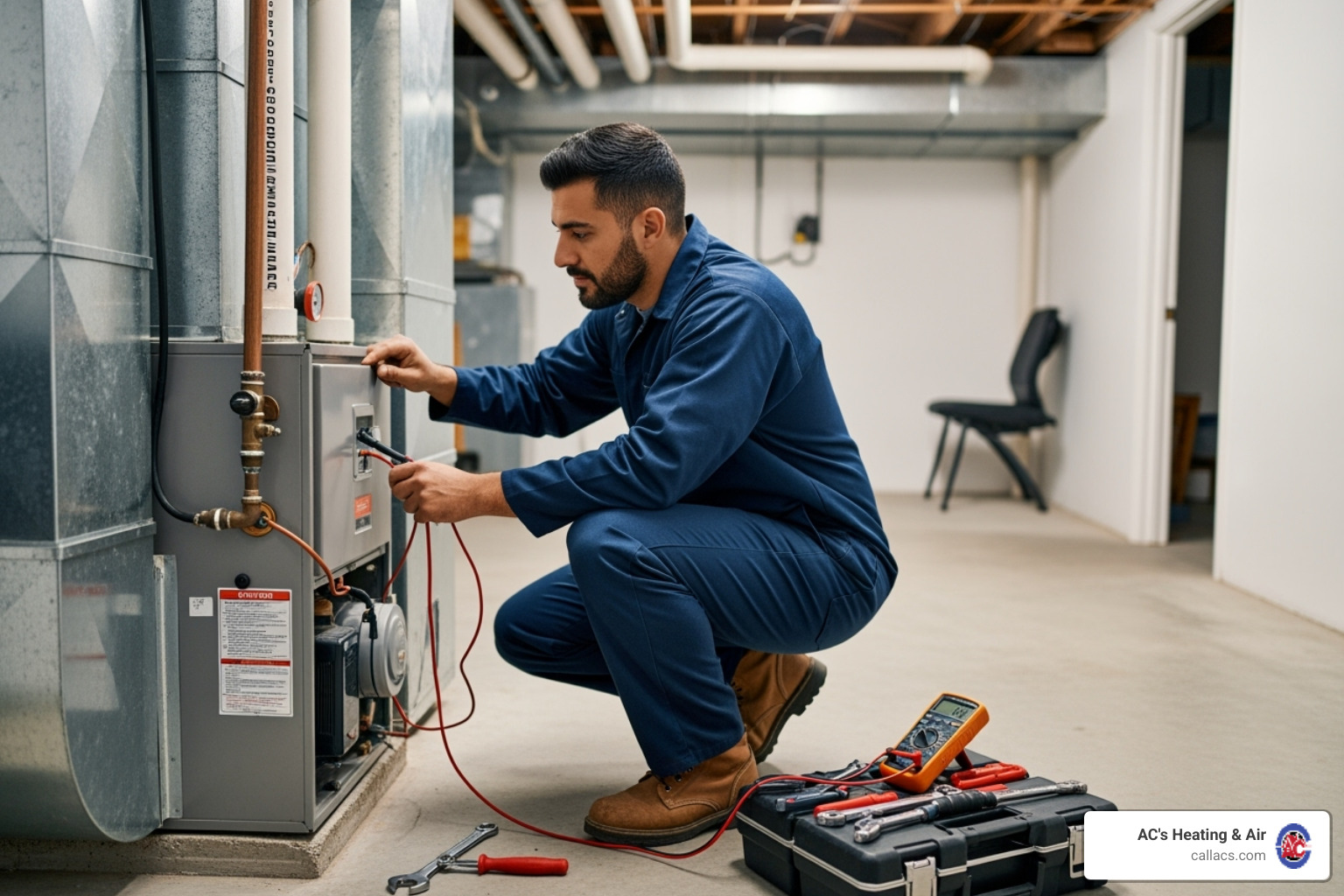Heating System Giving You the Cold Shoulder? Fix Your Gas Ducted Heater Now

When Your Gas Ducted Heating Gives You the Cold Shoulder
There's nothing worse than flipping the switch on a chilly Florida morning only to find your gas ducted heating not turning on. When your home's central warmth decides to take a break, it can quickly turn comfort into concern.
Before panic sets in or you reach for the phone, here are the immediate, simple checks you can do right now:
- Check your thermostat:
- Is it set to HEAT mode?
- Is the desired temperature higher than the current room temperature?
- Are the batteries fresh (if applicable)?
- Verify power supply:
- Is the furnace's power switch ON?
- Has the circuit breaker for your furnace tripped?
- Confirm gas supply:
- Is the gas shut-off valve near the furnace open?
- Is the pilot light lit (for older models)?
- Inspect air filter:
- Is it clean and free from heavy dust or debris? A clogged filter can cause the system to overheat and shut down.
These quick steps can often resolve common issues, saving you time and hassle.
As Allen Chenault, Owner and Founder of AC's Heating & Air LLC, I've spent over 8 years helping Central Florida homes resolve HVAC challenges, including when their gas ducted heating not turning on. Our mission is to provide reliable solutions that bring comfort and efficiency back to your home.

Essential gas ducted heating not turning on terms:
First Steps: Simple DIY Checks You Can Do in 5 Minutes
When your home feels more like an igloo than a cozy retreat, don't panic. Many common heating issues can be resolved with a few quick checks. These initial troubleshooting steps are often all it takes to get your gas ducted heating not turning on back in action, saving you time and a service call. For more general advice, see our Central Heating Troubleshooting Tips.
Check Your Thermostat Settings
Your thermostat is the brain of your heating system; sometimes, the fix is as simple as checking its settings.
The Usual Suspects: Airflow Issues That Stop Your Heater
Picture this: you're trying to breathe through a thick winter scarf wrapped around your face. Pretty uncomfortable, right? That's exactly how your gas ducted heating system feels when its airflow gets restricted. When your furnace can't "breathe" properly, it struggles to do its job – and sometimes it just gives up entirely.
Airflow problems are sneaky troublemakers that cause more heating headaches than you might expect. They're often the hidden culprit when your gas ducted heating not turning on, and they can turn an efficient system into an energy-wasting, comfort-killing nightmare. The good news? Many airflow issues are surprisingly simple to fix once you know what to look for.
When airflow gets restricted, your furnace's safety systems kick in to protect the equipment. This means your system might shut down completely, leaving you wondering why your Furnace Doesn't Blow Hot Air when you need it most.
How a Dirty Air Filter Causes Your Gas Ducted Heating Not Turning On
Here's a little secret from my years in the HVAC business: dirty air filters cause more service calls than almost any other single issue. It's amazing how such a simple, inexpensive part can bring your entire heating system to its knees.

Your air filter starts out life as a helpful gatekeeper, catching dust, pet hair, pollen, and all sorts of airborne particles before they can gum up your furnace's inner workings. But over time, that filter becomes so loaded with debris that it turns into a thick, impenetrable barrier.
When this happens, your furnace can't pull enough air through the system. Restricted airflow means your heat exchanger – the part that actually warms the air – starts getting dangerously hot because it can't cool itself down properly.
Your furnace isn't stupid, though. It has a built-in safety device called a limit switch that's constantly monitoring temperatures. When things get too toasty, this switch says "Nope, we're done here" and shuts everything down. This is often why your gas ducted heating not turning on – it's actually protecting itself from damage.
Here's how to check and replace your filter:
First, locate the filter – it's usually tucked into a slot in the return air duct near your furnace, or sometimes inside the furnace unit itself. Next, note the size printed on the frame (something like 16x20x1 or 20x25x1).
Pull that filter out and inspect its condition. Hold it up to a light source. If you can barely see light through it, or if it looks like it's wearing a thick gray sweater, it's definitely time for a replacement.
Replace with a new one, making sure the airflow arrow on the frame points toward the furnace. This little arrow is important – it shows which direction the air should flow through the filter.
I tell my customers to check their filter monthly and replace it every 1-3 months, depending on how much their system runs and whether they have pets. It's a small investment that prevents big problems.
Inspect for Blocked Vents and Ductwork
Your heating system is like a highway system for warm air – and just like traffic, blockages cause big problems. Even after warm air leaves your furnace, it needs a clear path to reach every room in your home.
Closed vents are a common issue I see. Some folks think closing vents in unused rooms saves energy, but it actually creates pressure imbalances that make your system work harder. Walk through your home and make sure all those supply registers (the grilles where warm air comes out) are fully open.
Obstructed registers are another frequent culprit. That couch pushed against the wall might be blocking a vent, or maybe a throw rug has shifted over a floor register. Even curtains hanging too close to a vent can redirect airflow. Take a quick tour of your home and move anything that might be playing interference with your warm air.
If you can access your ductwork in the attic, basement, or crawl space, look for obvious signs of damaged ducts. Disconnected joints, crushed sections, or visible holes can cause significant heat loss. While major duct repairs need professional attention, spotting these issues helps explain why your Furnace Not Heating Home evenly.
Your heating system is designed to work as a complete circuit. When that circuit gets interrupted anywhere along the way, it affects the whole system's performance – and sometimes causes your gas ducted heating not turning on at all.
Why Your Gas Ducted Heating Not Turning On Could Be a Mechanical Failure
If you've diligently checked all the simple things – your thermostat settings, power supply, gas valve, and even the air filter – and your gas ducted heating not turning on is still giving you the cold shoulder, it's time to consider that the problem might be a bit more complex. Modern gas ducted heaters are marvels of engineering, but like any intricate machine, they have many moving parts and sensitive components that can, over time, wear out or malfunction. When one of these essential pieces falters, it can bring your entire heating system to a grinding halt. These kinds of issues almost always require the keen eye and specialized tools of an HVAC professional for proper diagnosis and HVAC Repair. But don't worry, even complex problems have solutions, and we're committed to offering Affordable Heating Repair to get your warmth back.
Ignition System and Sensor Problems
Think of your furnace's ignition system and sensors as the meticulous conductors of an orchestra. They ensure that everything happens in the right order and safely. If even one of these components misses a beat, your furnace simply won't ignite or stay lit.
You might be dealing with a dirty flame sensor. This little metallic rod has a big job: it tells your furnace's computer that a flame is actually present after the gas valve opens. If it's covered in soot or grime, it's like wearing very dark sunglasses – it can't "see" the flame. When it can't confirm the flame, a safety mechanism kicks in, shutting off the gas to prevent buildup, meaning your burners never truly get going.
Then there's the faulty ignitor. Most modern furnaces have an electronic ignitor (either a glowing hot surface or a direct spark ignitor) that has replaced the old-fashioned pilot light. If this component is cracked, worn out, or simply not getting power, it won't be able to ignite the gas. No spark, no flame, and your furnace stays cold. For older systems that do use a standing pilot light, a thermocouple issue could be the culprit. The thermocouple is a safety device that senses the pilot flame; if it cools down because the pilot light is out, it shuts off the gas. A faulty thermocouple might wrongly believe the pilot is out, even when it's lit, causing the system to shut down.
Another common issue could be a pressure switch failure. This crucial safety component monitors the airflow within your furnace's venting system, making sure all those combustion gases are safely expelled outside. If it detects any blockage or issue (perhaps with the inducer draft motor), it will prevent your furnace from starting to avoid dangerous carbon monoxide buildup. Even something as simple as blocked sensing lines to the pressure switch can trigger this safety shutdown. And finally, similar to when your filter is clogged, a limit switch malfunction can cause problems. This safety device prevents your furnace from overheating. If it's faulty, it might trip prematurely, shutting down your furnace even when there's no real danger, or worse, it could fail to trip when it should, leading to hazardous conditions. Because these components are so vital to safety and proper function, diagnosing them accurately often requires specialized tools and expertise.
Blower Motor and Capacitor Failure
Once your furnace successfully heats the air inside, it's the blower motor's job to push that lovely warm air throughout your home's ductwork. If this motor isn't working, you won't feel any heat at your vents, even if the burners are firing perfectly.
A dirty blower motor can become unbalanced over time, leading to strange noises, reduced airflow, or even complete failure. If the motor fails outright, no air will circulate. Sometimes, you might hear a humming noise coming from your furnace, but no fan movement. This often means the motor is trying its best to start but can't quite get going. This brings us to the blower capacitor. This small, cylindrical component acts like a little battery, providing the initial burst of electricity needed to kick-start the blower motor. If this capacitor fails, the motor simply won't be able to turn on, even if the motor itself is perfectly fine. That humming noise without the fan spinning is a classic sign of a failing capacitor.
These issues are common reasons why your HVAC Heat Not Turning On effectively. Our technicians are well-versed in diagnosing and replacing these specific parts, ensuring that proper airflow and comforting warmth are quickly restored to your home.
Safety First: Recognizing Hazards and When to Call a Professional
When your gas ducted heating not turning on, it's more than just a chilly inconvenience; sometimes, it can signal a serious safety concern. Gas appliances, while wonderfully efficient, do come with inherent risks if they aren't working properly. Knowing when to simply troubleshoot and when to step back and call in the experts is absolutely vital for your family's safety. If you ever suspect any of the issues we're about to discuss, don't hesitate for a second – call for Emergency Furnace Repair right away.
What to Do If You Smell Gas
This is perhaps the most critical safety issue you might ever face with a gas heating system. Natural gas itself doesn't have a smell, which is why utility companies add a special chemical that gives it that distinct "rotten egg" or sulfur-like odor. This is your warning system!
If you ever smell that rotten egg odor:
- Do NOT touch any light switches, appliances, or electronics. A tiny spark could be enough to ignite the gas.
- Do NOT use your phone while you're still inside the house.
- Open windows and doors immediately to help ventilate the area.
- If it's safe and easy to reach, shut off the gas supply to your entire home at the main gas meter.
- Get everyone out of the house right away. Don't go back in for anything.
- Once you are a safe distance away from your home, call your gas utility company's emergency line and then 911. Only re-enter your home once a professional has confirmed it's completely safe.
For more comprehensive Gas safety information from a trusted source, it's always a good idea to review resources from Ready.gov.
The Dangers of a Malfunctioning Furnace
Beyond gas leaks, other furnace problems can pose serious risks that you need to be aware of:
Carbon Monoxide (CO): This is the silent killer. It's invisible, has no smell, and no taste. It's produced when gas doesn't burn completely, and a common culprit for leaks is a cracked heat exchanger inside your furnace. This crack can allow dangerous exhaust gases to mix with the air you breathe. Symptoms of CO poisoning can feel like a bad headache, dizziness, nausea, or just general flu-like symptoms. But prolonged exposure can be deadly. This is exactly why we can't stress enough how important it is to have working carbon monoxide detectors on every level of your home, especially near sleeping areas. Test them regularly!
Soot or Scorch Marks: If you notice black soot or scorch marks around your furnace or its vents, this is a big red flag. It often means there's an incomplete combustion issue happening, which can be a warning sign of carbon monoxide problems.
Electrical Hazards: Your furnace relies on electricity, and faulty wiring or components can lead to sparks, shorts, or even fire hazards. If you see sparks, or smell anything like burning plastic or electrical wires, the safest thing to do is to immediately shut off power to the furnace at your main circuit breaker.
Water Leaks: While not as immediately dangerous as gas or electrical issues, water leaks (often from a clogged condensate drain in high-efficiency furnaces) can still cause problems. They can lead to water damage, mold growth, and can even short out electrical components if left unchecked.
When it comes to gas or major electrical issues, never try to fix them yourself. These critical repairs always need the specialized knowledge and tools of a qualified HVAC technician. Your safety is always our top priority.
The Power of Prevention: Stop Problems Before They Start
We often hear it: "My heater was fine last season, why isn't it working now?" It’s a common question, and the answer often boils down to one simple thing: maintenance. Just like your car needs regular oil changes, your heating system— a complex machine working hard to keep your family warm—truly thrives on consistent care. In fact, a lack of regular maintenance is probably the number one reason we get service calls for heating issues during the cooler months.
Investing a little time and effort into preventative care is the very best way to avoid your gas ducted heating not turning on unexpectedly. It's not just about fixing problems when they happen; it's about making sure they don't happen in the first place! This approach not only helps your system last longer but also keeps your energy bills lower and gives you wonderful peace of mind. That’s why we always recommend regular Furnace Maintenance.
Why Regular Maintenance is Crucial for Your Gas Ducted Heating Not Turning On

During a professional maintenance visit, our certified technicians perform a thorough series of essential steps. We start with preventative checks, carefully looking for any small issues that could grow into big, costly breakdowns later on. We then focus on cleaning components, making sure vital parts like the burners, flame sensor, and blower are free of dirt and dust, allowing them to work efficiently. Dirty components are a leading cause of furnace failure!
Our team also takes the time for lubricating parts, ensuring that all moving components, like the blower motor, run smoothly to reduce friction and wear. One of the most important aspects of our visit involves safety inspections. We rigorously check for gas leaks, carbon monoxide leaks (especially looking for cracks in the heat exchanger), and any electrical hazards. This step is absolutely crucial for the safety of your family and home. Finally, we perform system calibration, making sure all controls and settings are perfectly tuned for your furnace to operate at its very best.
Regular maintenance doesn't just prevent those frustrating "no heat" moments. It helps your system run at peak efficiency, which directly translates to lower energy bills for you. It also significantly extends the lifespan of your furnace, saving you from needing expensive replacements sooner than necessary. Most importantly, it ensures your system operates safely, protecting your home and family from potential dangers like carbon monoxide.
To make it easy for you to keep your system in top shape, we offer various HVAC Preventive Maintenance Plan options and comprehensive HVAC Maintenance Plans custom to your specific needs here in Central Florida. Let's keep your home warm and cozy!
Frequently Asked Questions about Gas Ducted Heating
We understand that owning a gas ducted heating system can bring up a few questions. From routine care to unexpected smells, it's natural to wonder about the best way to keep your home cozy and safe. Here are some of the most common inquiries we receive from homeowners like you:
How often should I have my gas ducted heater serviced?
Think of your gas ducted heating system like your car – it needs regular check-ups to run its best! While some manufacturers might suggest every 2-3 years, we, along with most experts, strongly recommend having your gas ducted heater serviced at least once a year.
Why annually? Even in Central Florida, where our heating systems might not work as hard as up north, that yearly visit, ideally before the heating season kicks off, is crucial. It ensures any dust that's accumulated over the warmer months is cleared, all components are working correctly, and your system is truly ready to deliver warmth safely and efficiently when you need it most. Plus, regular maintenance often helps fulfill those important warranty requirements.
Why does my heater smell like it's burning when I first turn it on?
It can be a bit alarming when your heater kicks on for the first time in a while and you catch a whiff of something burning! Usually, if your gas ducted heating emits a slight, dusty burning smell when you first fire it up after a long period of inactivity (like at the start of winter), it's completely normal. This is typically just dust that has settled on the heating elements or burners, burning off as the system warms up. This "dust burn-off" smell should dissipate within a few hours.
However, if that burning smell persists, is very strong, or smells distinctly like burning plastic, rubber, or electrical wiring, that's a different story. If you notice any of these more concerning odors, turn off your system immediately and give a professional a call. Such smells could indicate a more serious issue like an overheating motor, damaged wiring, or other internal component problems that need immediate attention to prevent further damage or even fire hazards.
Can I fix my gas heater myself?
We totally get the urge to tackle things yourself! And the good news is, you absolutely can perform some basic troubleshooting steps, as we've outlined earlier. These include simple checks like ensuring your thermostat settings are correct, verifying the power supply (checking circuit breakers and the furnace switch), confirming the gas supply to the unit is on, and inspecting or changing your air filter. These quick and easy steps often resolve the most common reasons why your gas ducted heating not turning on.
However, when it comes to problems involving gas lines, complex electrical components beyond a tripped breaker, internal mechanical failures (like ignitors, flame sensors, pressure switches, or blower motors), or if you detect any gas odors at all – that's when it's crucial to step back and call a professional. Attempting to fix complex gas or electrical issues without the proper training and tools is extremely dangerous and can lead to serious injury, carbon monoxide poisoning, gas leaks, or even fire. For anything beyond the most basic checks, always prioritize your safety and trust a certified HVAC technician.
Don't Be Left in the Cold – Get Expert Help Today
Whew! You've made it through our troubleshooting guide, and we truly hope you've found the answer to why your gas ducted heating not turning on. It's empowering to know that many common issues, from a simple thermostat tweak to a quick filter swap or a flick of a breaker, can often be resolved with a bit of DIY detective work. Give yourself a pat on the back for tackling those initial steps!
However, we completely understand that heating systems can be quite complex, and sometimes, the problem runs deeper than a simple fix. More importantly, when it comes to your home's gas and electrical systems, safety should always be your top priority. If you've tried our troubleshooting tips and your system is still giving you the cold shoulder, or if you've noticed anything alarming like a gas smell, carbon monoxide alarm, or strange electrical issues, it's definitely time to bring in the pros.
That's where we come in! At AC's Heating & Air, we're passionate about keeping homes throughout Central Florida warm, safe, and comfortable. Whether you're in Apopka, Winter Park, Orlando, Winter Garden, or the beautiful communities of Orange County, Isleworth, and Celebration, our certified technicians are ready to help. We're experts in diagnosing and repairing all types of gas ducted heating systems, and we pride ourselves on providing reliable, prompt service to get your heat back on as quickly as possible.
Don't let the chill linger! When you need reliable and prompt service, trust our experts for your furnace repair needs. We're just a call away from bringing warmth and peace of mind back to your home.



